Sync.com vs pCloud – Every Inch Explored
Uf, now we’re talking business! I’m excited to compare the two best cloud storage providers at Cloudstorageinfo.org: Sync.com vs pCloud. pCloud has about +10.000.000 users while Sync.com sits at about +1.800.000. Both are very popular due to the amazing features they offer alongside the client-side encryption to ensure the security and privacy of your files! Read the comparison down below and check the individual reviews: Sync.com vs pCloud.
 | 4.6/5 ★★★★★ |
| PRICING & PLANS ★★★★★★★★★★ | 9.5/10 |
| EASE OF USE ★★★★★★★★★✩ | 9.0/10 |
| FILE SYNCING ★★★★★★★★★✩ | 9.0/10 |
| FILE SHARING ★★★★★★★★★★ | 9.5/10 |
| RETRIEVING FILES ★★★★★★★★★★ | 9.5/10 |
| SECURITY ★★★★★★★★★★ | 10.0/10 |
| SUPPORT ★★★★★★★★✩✩ | 8.0/10 |
| ADDITIONAL FEATURES ★★★★★★★★★✩ | 8.5/10 |
PROS
- Zero-Knowledge platform
- Not subject to US Patriot Act
- Client-side encryption
- 30-day money back guarantee
- Easy to use, modern platform
- Great syncing, sharing and file retrieving options
- Unlimited bandwidth
CONS
- No live chat/phone support for individuals
 | 4.6/5 ★★★★★ |
| PRICING & PLANS ★★★★★★★★★★ | 10.0/10 |
| EASE OF USE ★★★★★★★★★✩ | 9.0/10 |
| FILE SYNCING ★★★★★★★★★★ | 10.0/10 |
| FILE SHARING ★★★★★★★★★✩ | 8.5/10 |
| RETRIEVING FILES ★★★★★★★★★✩ | 8.5/10 |
| SECURITY ★★★★★★★★★★ | 9.5/10 |
| SUPPORT ★★★★★★★★★✩ | 8.5/10 |
| ADDITIONAL FEATURES ★★★★★★★★★✩ | 9.0/10 |
PROS
- Up to 10 GB of free storage
- Amazing syncing solutions
- Unlimited transfer speeds
- Easy to use
- Unlimited file sizes
- Client-side encryption
- Innovative lifetime plans
- US & EU Servers
- Desktop folder backup included
CONS
- No client-side encryption in the free plan
- No dedicated live chat/phone support

Jump to:
Pricing & Plans
Ease of use
File syncing
File sharing
Retrieving files
Security
Online support
Additional features
Conclusion
Pricing & Plans
Sync.com
Sync.com offers a variety of plans. They vary from the 5 GB free offer to the larger 6 TB capacity plans. Going for those will also give you access to certain advanced features. When compared to other cloud storage providers they’re without a doubt offering great value for the money. A 30-day money-back guarantee comes on all their plans. Sync.com doesn’t offer any lifetime cloud storage plans.
All the plans are paid yearly and not monthly.
| Plan | Personal Free | Solo Basic | Solo Professional |
|---|---|---|---|
| Storage | 5GB | 2TB | 6TB |
| Data transfer | 5GB | Unlimited | Unlimited |
| File versions & recovery | 30 days | 180 days | 365 days |
| Account rewind | No | Yes | Yes |
| Advanced share controls | No | Yes | Yes |
| Restrict downloads | No | Yes | Yes |
| Sharing links | 3 | Unlimited | Unlimited |
| Team shared folders | 3 | Unlimited | Unlimited |
| File requests | No | Yes | Yes |
| Document previews | No | Yes | Yes |
| Offline access | Yes | Yes | Yes |
pCloud
pCloud offers 10 GB of cloud storage for free. They have 2 paid plans when it comes to the amount of storage you get. Client-side encryption is available via their Crypto plan. pCloud was also the first cloud storage provider to successfully introduce lifetime cloud storage plans in return for a single payment. Those are quite interesting since they can save you money in the long run. A 10-day money-back guarantee is put on all their plans.
Monthly Plans
The prices above are displayed if you pay Yearly. If instead, you go for monthly payments, you end up with $4.99/month for 500 GB and $9.99/month for 2000 GB.
Lifetime Plans
Sync.com vs pCloud Round 1 Thoughts
pCloud and Sync.com are both amongst the best providers when it comes to value for the provided money. Sync.com gives you more options with higher storage capacities and provides you with client-side encryption from the get-go but requires you to commit to a yearly membership. pCloud, on the other hand, requires you to subscribe to an additional Crypto plan which enables the client-side encryption but they provide lifetime plans which are great in my opinion.
Proclaiming one being better than the other here is quite hard since they both offer valuable benefits in their own right. I’ll put pCloud on top here just because of their lifetime plans which can save you a lot of money in the long run.
Pricing & Plans Winner: pCloud
Ease of use
Sync.com

Sync.com has a modern and responsive UI. I’ve had no problems using it. Cycling through files feels good and allows me to manage my files in the same folder structure that I would use on my computer. It’s possible to cycle between the grid and list view though I prefer the list view due to its simplicity.
The “Vault” feature allows me to store files and folders just in the cloud. Data in the “Vault” won’t be synchronised to my devices which is a nice little feature to have. It’s also possible to look at all file changes via the “Events” tab which comes in useful if you share folders/files with somebody.
It’s possible to preview Office and PDF documents directly from the browser which is nice. It’s also possible to preview images but you can’t watch movies or listen to music. Editing the Office files requires an Office 365 license which is then integrated with Sync.com.
pCloud
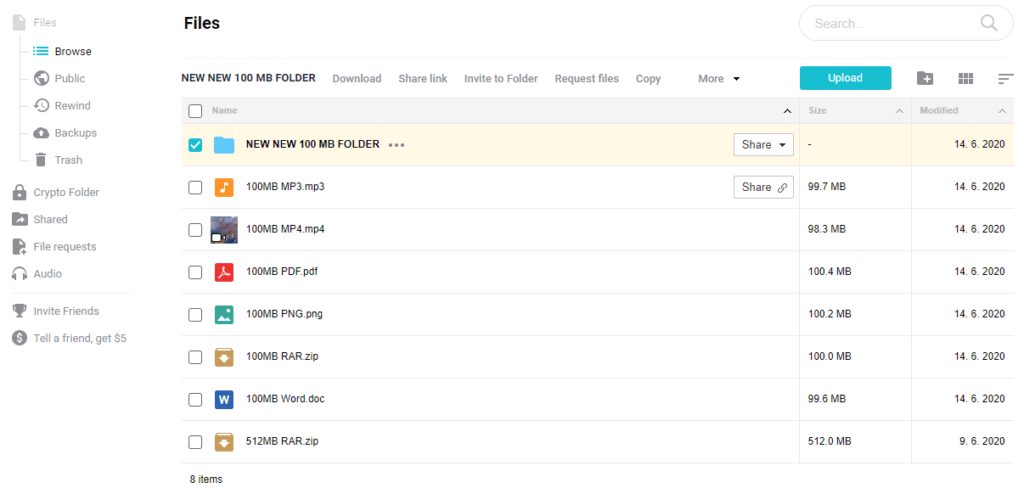
pCloud features a well-made UI. Perhaps it’s not the most modern-looking one but it without a doubt does the needed job. I actually prefer for the UI to be as simple looking as possible with all the needed “actions” accessible at a moments notice. And pCloud does just that.
- Files – Allows you to manage your files.
- Crypto Folder – Accessible to those that upgrade to the Crypto plan which enables client-side encryption.
- Shared – Shows all the files you shared with people and what they have shared with you.
- File requests – Enables you to manage all of the pending file requests, shutting them down or changing their settings.
- Audio – Displays all the sound files in one place and allows you to play them.
It’s possible to preview both Office and PDF documents directly from the browser but you can’t edit them. Watching movies, listening to music and previewing images is all likewise possible. That is all available outside the Crypto folder. These actions are more restricted in there due to the client-side encryption.
Sync.com vs pCloud Round 2 Thoughts
Taking a look at just the UI of both providers this round brings us to another hard choice. While Sync.com offers a more slick-looking design they both do the file management quite well. Sync.com also offers that sweet “Vault” feature. Unfortunately, they can’t provide the level of accessibility that pCloud does due to the fact that they cover all of the files with client-side encryption. That is a plus from the security standpoint for sure but it does restrict features like file previewing & watching. pCloud, on the other hand, divides your files into two parts. One that allows you to interact with your files with no client-side encryption and one that is far more limited. And that’s the reason why pCloud takes round 2 as well!
Ease Of Use Winner: pCloud
File syncing
Sync.com
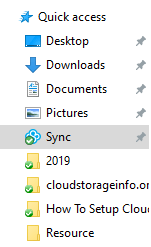
Sync.com client is available on Windows and macOS systems. During the installation of the client, you choose where you want your files from the cloud synced to locally. Whenever you make a change in that folder it will be recognised in your cloud as well.
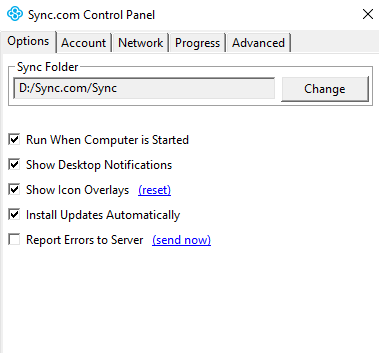
The Sync.com control panel also allows you to edit various settings such as set the sync folder, change the password, set up/download speeds, set monthly bandwidth limits and select which files you want synced to that specific device (selective sync).
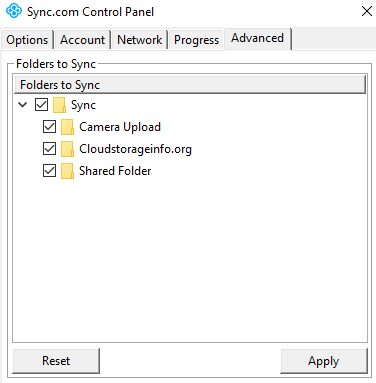
Transfer speeds between you and the cloud are limited to 5 MB/s. They do support file-deduplication but can’t support block-level sync due to the client-side encryption put all over your files. It’s also not possible to sync any folder from your computer. No file size limits though so that’s good!
pCloud
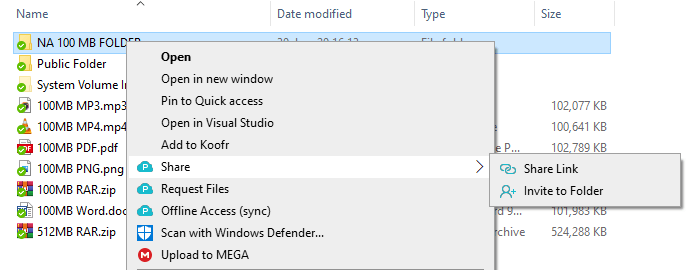
pCloud client is available on Windows, macOS and Linux systems. pCloud creates an imaginary drive on your computer which takes up no local storage space. That’s a very neat feature if you want to save up space. It’s still possible to mark files for offline access if you plan to use your computer without an internet connection. It’s also possible to sync any folder from your computer to the cloud.
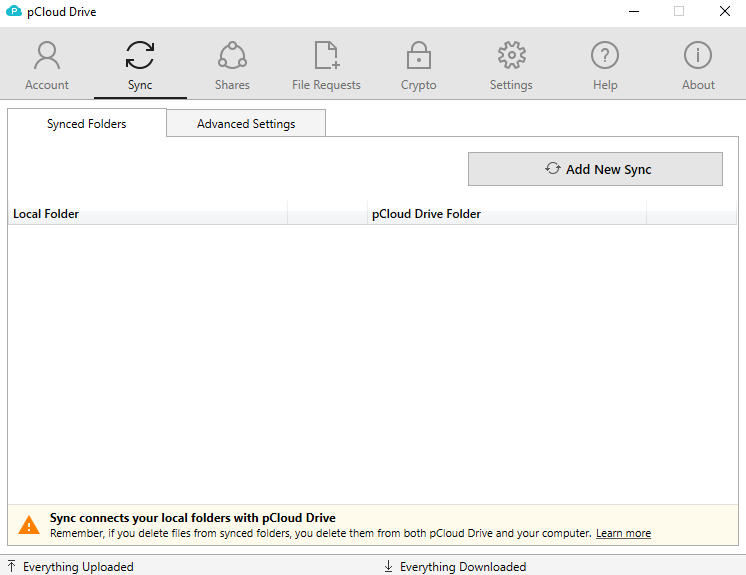
There’s no hard limits on transfer speeds though you can limit them yourself. There’s also no limit on file sizes.
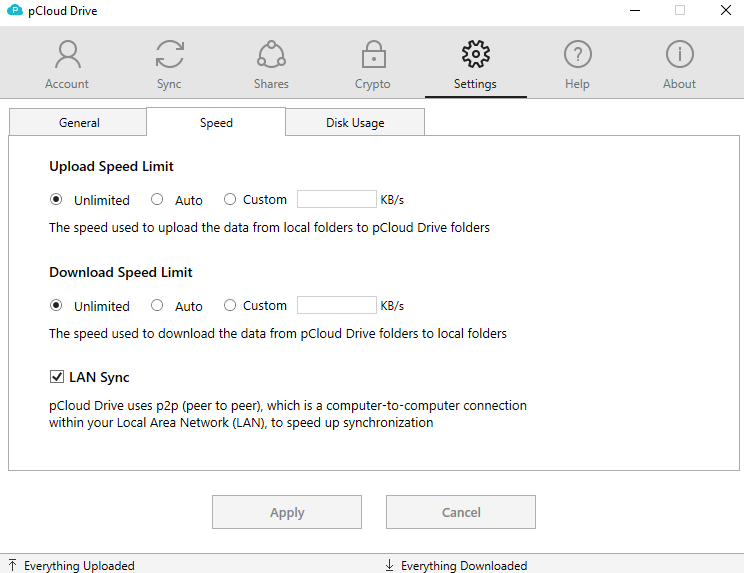
pCloud also provides block-level file sync for the section that’s not encrypted client-side (so not the Crypto folder). That shortens the time needed to upload updated files.
Sync.com vs pCloud Round 3 Thoughts
Phew, another hard-fought battle. Both Sync.com and pCloud do exceptionally well when it comes to file synchronisation and their desktop clients. pCloud has that main selling point which is that the files don’t take up any space on your local storage (apart from cache). They also provide block-level file sync for the non-encrypted folders, something that Sync.com can’t do. pCloud also allows you to sync any folder from your computer, a very useful feature! Sync.com provides a quality solution but just gets beaten by pCloud in this area.
File Syncing Winner: pCloud
File sharing
Sync.com
There are 2 ways of sharing files with Sync.com. The first one being the download links which are available with almost all cloud storage providers. You simply create a link that you can pass on to anyone and he can download the files/folders you have shared.
The free users are limited to 5 GB per month in regards to sharing links bandwidth. All other plans have unlimited bandwidth.
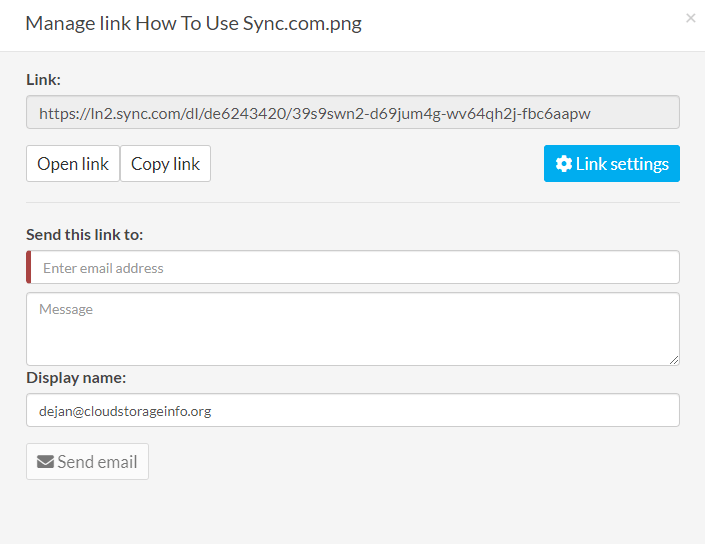
There are plenty of advanced features available when it comes to sharing via the link. Sync.com does exceptionally well here:
Starter Plan:
- Password-protected links
Paid plans:
- Set expiry dates.
- Set preview permissions (view&download or view only).
- Set download limit.
- Enable email notifications.
- Enable enhanced privacy (zero-knowledge links).
- Link branding
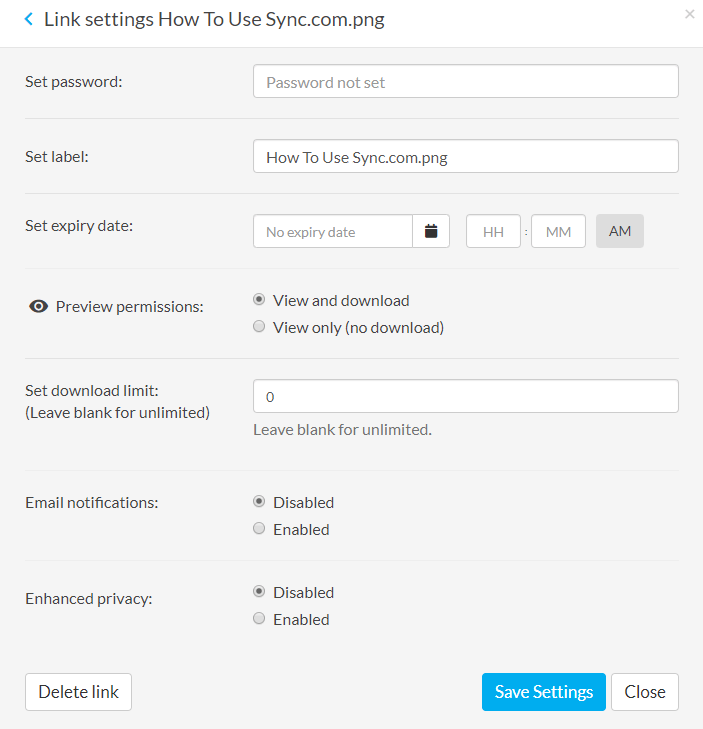
The second option you have is sharing complete folders to specific people that have a Sync.com account as well.
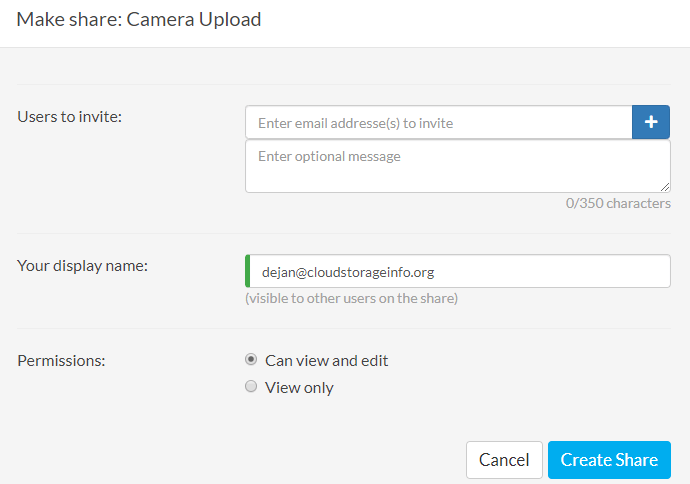
pCloud
Let’s divide sharing of files within pCloud into 2 main categories: Sharing folders and sharing files. They’re pretty much the same but sharing folders comes with extra features:
- Invite to a folder – This allows your friends to view, download and/or modify the files as if they were their own.
- Share link – Generates a link with specific settings that can be sent to friends and coworkers for file sharing.
- Request files – Request files from anyone through a specific link.
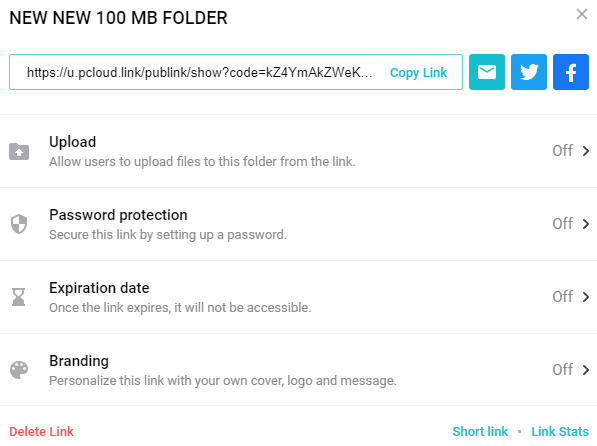
When it comes to sharing links you’re able to:
- Upload – Allow users to upload files to the folder or not. Presents with 3 different options: “Nobody can upload”, “Anyone can upload”, “Only selected users can upload”.
- Password protection [Premium] – Protects the generated link with a password which should then be shared with the people that should gain access to the folder.
- Expiration date [Premium] – It allows us to put a time limit on the link which is great for setting up a link and then easily forgetting about it. Awesome from the security and privacy perspective.
- Branding – Allows for a custom title, description, logo image and background image to be used for the sharing link. Works great and looks professional, especially suitable if you plan to use pCloud as part of your business.
- Short link – Great for sharing on social media such as Twitter where we’re limited with character number.
- Link Stats – Displays the weekly stats for a specific link. Includes the link creation date, total downloads and total traffic.

Sharing an entire folder with someone is also simple and gives you the option to either give them view or edit access.
Requesting files grants no permission to modify or view the files in the folder. Instead, the person can only upload his own file. It’s also possible to set an expiry date or a file size limit on the link.
Sync.com vs pCloud Round 4 Thoughts
While pCloud provides an additional third option (requesting files) it doesn’t grant advanced features such as preview permissions, download limit, email notifications and zero-knowledge links. You also get the password-protected links in the free plan with Sync.com. They both offer link branding for business users. Both cloud storage providers offer great features here but in my eyes, Sync.com comes out on top.
File Sharing Winner: Sync.com
Retrieving files
Sync.com
Sync.com offers both a file versioning and trash bin system. The duration of how long the files stay accessible to you depends on the plan you have with them. In the free option, you can access the files for up to 30 days, 180 days in the 2TB plan and 365 days with the 6TB plan. The Rewind feature is available for all paid users – it requires a sent email to their support team which then resets your account to a point in the past.

pCloud
pCloud features both a file versioning and trash bin system with the addition of the “Rewind” feature. File versions and deleted files are stored for 15 days with the free plan and 30 days with all the premium plans.
pCloud also offers “Extended file history” which moves that duration to 365 days for additional payment.
The “Rewind” feature allows you to see your account as it was on a specific date and time. The same timings apply here (15, 30 and 365 days with EFF).

Sync.com vs pCloud Round 5 Thoughts
Both Sync.com and pCloud support file recovery. The “Rewind” feature that pCloud offers is much more simple to use than the one Sync.com has but Sync.com offers far longer durations without the additional cost. That’s why Sync.com wins this round in my eyes.
Retrieving Files Winner: Sync.com
Security
Sync.com
Sync.com has its servers located in Canada – Toronto and Ontario. They use client-side encryption to maximize the security of your files. That makes them a zero-knowledge platform combined with a strong privacy policy. What does that mean? All of your files and information are encrypted with keys that only you have access to. You can say goodbye to any government interventions and the possibility of your files being hacked. Not even Sync.com administrators can access your files.
For the tech-savvies: Sync.com uses 2048 bit RSA, 256 bit AES, SSL and TLS encryption.
Compliances:
Sync.com is also HIPAA compliant which means it’s suitable for companies and firms that are dealing with sensitive patient information. Every institution that is dealing with such information must be part of a network or cloud that is HIPAA compliant.
They’re also compliant with EU GDPR and PIPEDA. Canada has its own set of privacy laws known (PIPEDA being one of them). We have covered all the relevant ones in this article.
Additional security:
To make your account even more secure, you can enable Password Hints, Two-Factor Authentication, Automatic Logout. In addition to that, your password can’t be recovered by anyone, not even yourself. This can be bypassed by enabling Password Recovery in the settings before you lose it, or by changing your password in the desktop application.
Subpoena:
If Sync.com receives a subpoena, demanding the data stored on the server the following will happen: The content of the files that you store on their service is encrypted, and only you can decrypt it. Thus they will not be able to decrypt your data. If they’re demanded to disclose your personal information such as your name, e-mail and mailing address they will do so. They will also do anything in their power, within legal boundaries, to inform you that your personal information has been disclosed.
pCloud
pCloud stores all of your data in servers owned by them located in the US and EU. It’s possible to pick your desired location upon registration. Files will then be stored there and won’t be moved without your permission or knowledge. Every file is stored in at least 3 various server locations, divided and stored in 15 different racks.
pCloud uses TLS/SSL encryption with data in transfer. If you want client-side encryption you can go for their Crypto plan which does just that. Nobody but you will be able to access those files.
pCloud Crypto is the thing you should pay attention to here. In fact, pCloud is the first cloud storage provider to offer both client-side encryption and server-side encryption. You might ask yourself, what are the advantages of that? Why not simply do client-side encryption across all files and with that disable any sort of access by the government authorities? There’s one big downside. Encrypted files can’t be accessed by anyone. Even the servers and processors don’t understand the data. That way all possible applications such as image previews, playing videos and music directly in the cloud, previewing documents,… aren’t possible.
It is for that reason that pCloud has both the client-side encryption (zero-knowledge) where you can place your important files and the server-side encryption where you can place music, videos and other stuff. That is if you wish to view them directly in the cloud. You can still opt-in to upload everything to your Crypto folder and unlock that whenever you need it.
They’re fully GDPR compliant. They are also compliant under the ISO 9001:2015 – Quality Management Systems (QMS) and ISO 27001:2013 – Information Security Management Systems (ISMS).
pCloud also offers two-factor authentication.
They have no security breaches on their record and it looks like it will stay that way.
Sync.com vs pCloud Round 6 Thoughts
Phew, that was a long one and justly so. Both Sync.com and pCloud care about the security of your files. While pCloud offers client-side encryption it comes at an additional cost. They also have their servers located in the US which is why I recommend getting the Crypto plan to avoid any privacy issues (due to the Patriot and CLOUD act) if you plan to store your files on their US rather than EU servers. Sync.com, on the other hand, encompasses all of your files and protects them with client-side encryption. The HIPAA and PIPEDA compliances also speak for themselves. That’s why I believe Sync.com to be the winner of this round.
Security Winner: Sync.com
Online support
Sync.com
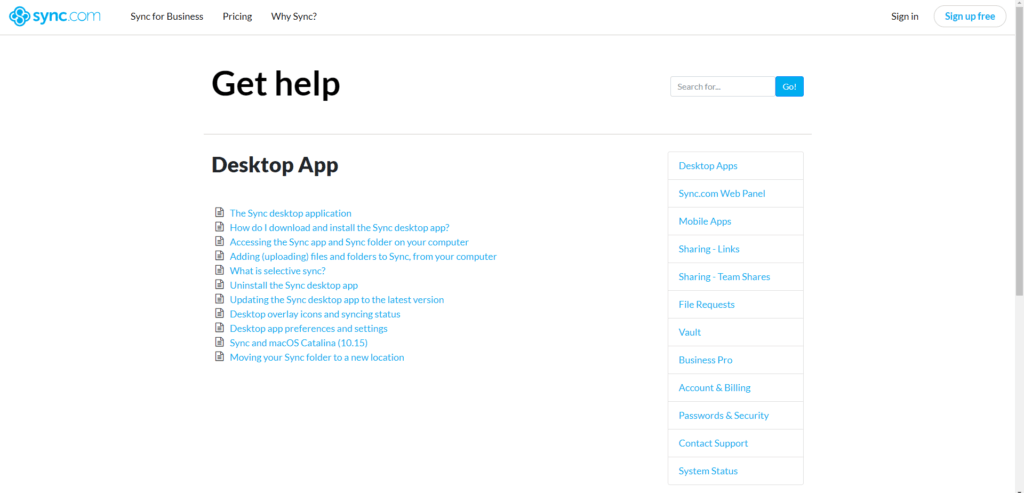
Sync.com offers a large FAQ base, mostly in the form of various guides with included pictures. That’s all great but you just want to have that additional support options. You can contact them via their support form and they will get back to you, usually within a day. They don’t offer any live support though such as live chat or phone calls for idividuals. Phone call support is reserved for users on the Teams Unlimited plan.
pCloud

If you have any questions, it’s very probable that they have already been answered in the pCloud FAQ base. They have answered and explained most of the topics there and it’s really great to see such dedication from the company. If you need additional help you can contact them via their contact form and they’ll reply in a timely manner. Live chat or phone call support are out of the question.
Sync.com vs pCloud Round 7 Thoughts
Both Sync.com and pCloud offer about the same level of support with pCloud really giving it that push with their FAQ base. Not many cloud storages offer live support for personal users so I would say they’re pretty much up to standard when it comes to the support options.
Online Support Winner: pCloud
Additional features
Mobile Application
Sync.com
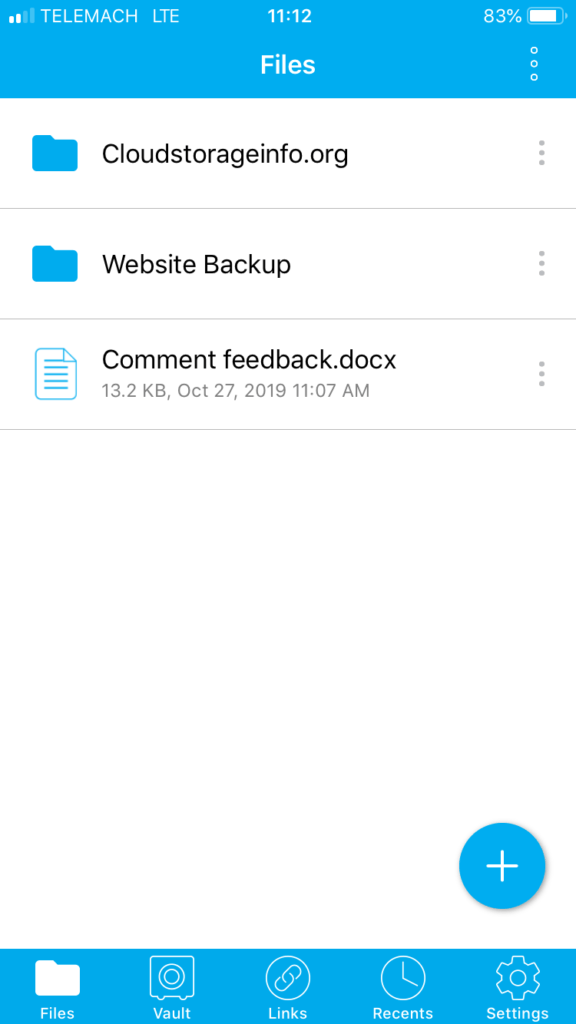

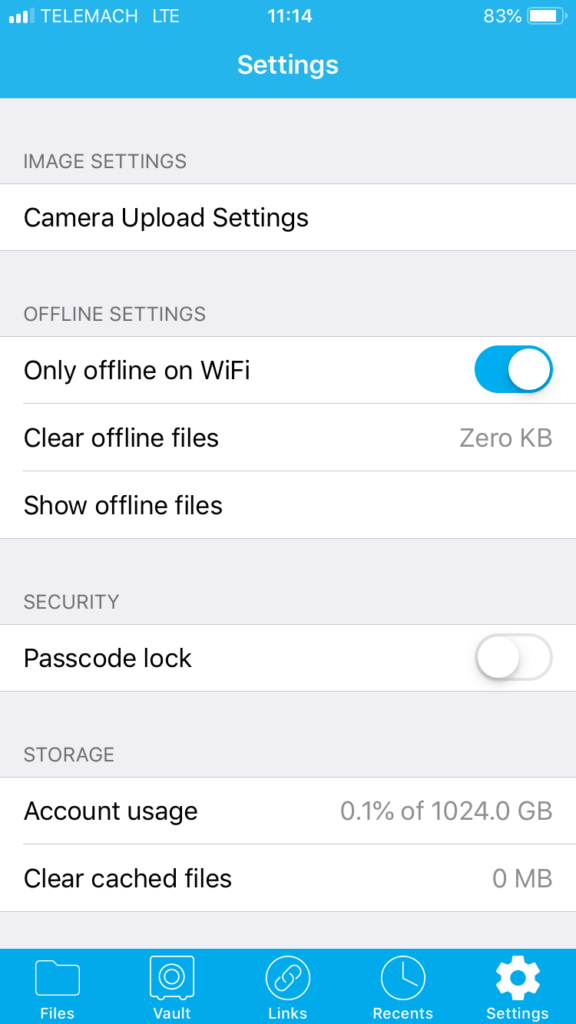
Sync.com app is available for Android and iOS systems. It allows you to access the files you have in the cloud right from your mobile device. All of the features that are available from your desktop can be access via the app as well. It’s also possible to enable automatic upload of camera files which makes it a great backup solution. Marking files for offline usage is also a thing, allowing you to access them without an internet connection.
pCloud
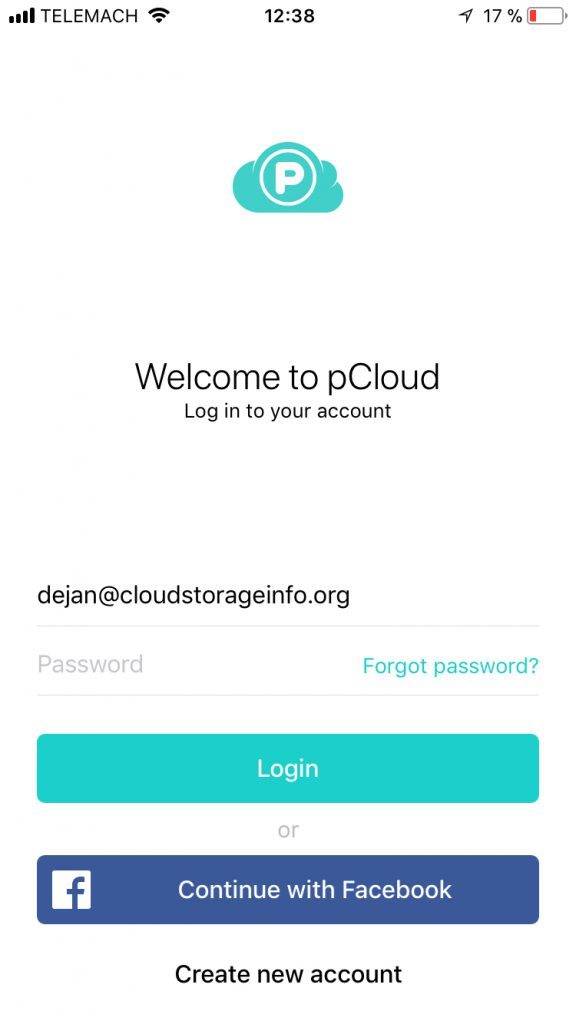
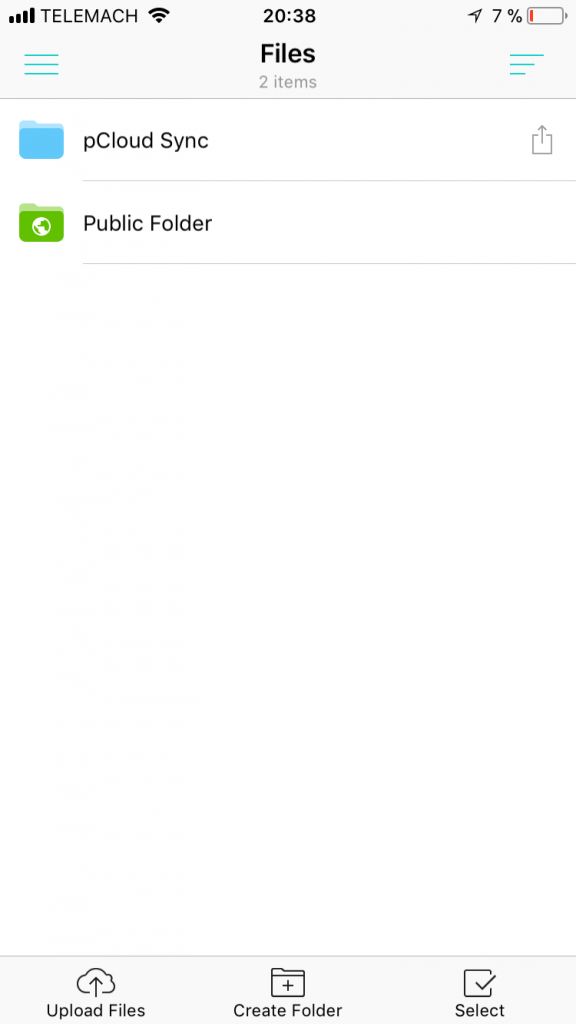

pCloud app is available for Android and iOS systems. It allows you to access and manage your files directly from your mobile device. In addition to the automatic upload media files, it also gives you the option to auto-delete them as they’re being uploaded.
Apart from that, you can watch videos, preview images, Office and PDF documents and listen to music directly from the app.
Sync.com Additional Features
Events

It’s quite straight forward. The events tab allows you to see the activity on your account and what’s happening with your files. Great for having oversight over your files.
Vault
The Vault that I have already mentioned previously under “Ease of use” makes for a great additional feature. Having the compartment of files that aren’t synced to your local device is great for storing files you don’t need on a daily basis.
pCloud Additional Features
Public folder

Public folder allows you to get links to specific files and freely share or embed those links anywhere on the web. That’s quite useful if you’re for example making a portfolio and need to embed your image into it.
pCloud Save & Remote Upload

pCloud Save is an extension for the following browsers: Google Chrome, Opera and Firefox. It allows you to save images, text content and other files directly to the cloud from the web. That eliminates the need to download them to your desktop and makes for a great time-saver.
Remote Upload is a feature that has the same functionality as the pCloud Save extension. Simply take a link to a video or an image and place it directly in the pCloud upload manager. The files will then be downloaded directly to the servers of the provider, eliminating the need to save them locally first.
Free accounts get 15 GB of one-time Remote Upload traffic while premium users get an unlimited amount.
pCloud Backups
You can backup multiple platforms directly within the pCloud dashboard: Google Drive, Dropbox, Facebook, Instagram and OneDrive. It makes for a useful feature if you are using multiple cloud storages or you would like to save your pictures that have been uploaded to the social media.
It’s also possible to backup your WordPress website.
Conclusion
Sync.com vs pCloud: What a battle this was. Not only do pCloud and Sync.com take up the top 2 spots on my Top 10 Cloud Storage Providers list, but they also come crazy close when it comes to my rating of their features. To sum up the comparison:
- Both pCloud and Sync.com offer great pricing plans when compared to other providers but pCloud also offers lifetime cloud storage plans.
- Both are very easy to use and have great user interfaces. Sync.com has a more modern looking one but pCloud offers more actions such as video streaming and listening to music.
- Both provide a great synchronisation client but pCloud takes up no local storage space with their imaginary drive.
- Sync.com provides a wider array of advanced sharing capabilities.
- pCloud offers a more easy-to-use “Rewind” feature for retrieving your files but Sync.com offers longer file retrieving periods at no additional cost.
- Sync.com offers better security and privacy due to the client-side encryption placed across all your files (pCloud offers that just in the Crypto plan) combined with their strong privacy policy (HIPAA and PIPEDA compliant).
- They both offer practically the same online support options, pCloud having a slight edge over Sync.com with a larger FAQ base.
After going through all the features both cloud storage providers offer I believe it’s important that you decide which is best suited for your needs rather than me telling you which one is better overall. Have a look at the features and decide based on that. Both are one of the best services on the market right now so you won’t go wrong with either of them!
Hopefully, we’ve gone through everything that you wanted to know about the comparison Sync.com vs pCloud. If you have any more questions, feel free to ask in the comments section down below and I’ll answer shortly!

Hello Dejan, thanks for your most detailed review, in addition to your detailed. Responses to the questions asked.
What I am looking for a cloud storage to do is to replace Google as backup cloud storage. I’m maxed out at 15GB and would like to transfer that 15GB of data to a different cloud storage (who wants to spend the $$$ that Google charges for added storage?!
The majority of my content, other that emails attachments, comes from the Photos and Videos taken on my cell phone….. so replacing Google on my cell phone to a different backup destination is a requirement,
What would you recommend? It is for both my wife and myself.
Regards,
Canada
Hi Mark, thanks.
So, you would like to keep 15 GB and probably have some extra GB while keeping the service free. And also have the Photos and Videos on your phone backed up automatically if I understand correctly. Have you looked into Mega? And if you wouldn’t mind paying for the service, I would definitely try pCloud or Sync.com that are mentioned in the above comparison.
Best,
Dejan
Hello Dejan and thank’s for the great articles you’ve wrote so far.
Regarding free plans I’ve tried so far, I must say that pCloud’s UI is much better for me, and video player as well as music player (ability to create playlist) are really great!
The upload speed in not comparable for me, pCloud does it much much faster then Sync.
Idk if that has something to do with Sync’s encryption prior to upload.
Also, I must say that pCloud’s free space maximum is 10GB, while with Sync you can get up to 26GB via referrals…
Will mention that pCloud closed my account for having few people joining from the same IP address, which in my case are 2 apartments with 7 people using same wifi and 3 laptops. So that one pushed me away from pCloud tbh.
Anyway, wanted to ask you regarding Sync’s zero knowledge thingy…
So they encrypt the file before it’s uploaded?
Like on client side (desktop app or if I’m using only web browser), when I want to upload file, they encrypt it so they cannot access/read it on their server.
How can I preview/open files via browser then?
Is it something like the sole fact that I logged in with my password, I hold the decryption key so files are decrypted for me on my client?
And one more, did you have same speed issues with Sync (I’m testing from Serbia), and how big speed drop can I expect from both of them (considering the fact that Google can probably provide best speed all across the Globe) when I travel to Middle East for example?
Thank you in advance
Hey there, Pozdrav 🙂
Really glad you found the articles useful. I also find the pCloud UI better, it doesn’t look as modern as Sync.com but it has that “classic” vibe to it and I prefer that, especially with using the “List” view. In regards to speed, using the Ookla speed test I get 195/5.5 Mbps (Download/Upload) from Ljubljana, Slovenia which means that the fastest upload time is around 02:25. I went on pCloud and Sync.com right now and tried uploading a 100MB RAR file, the results for uploads are (both tests done via the browser, not the desktop app):
– Sync.com: 06:08
– pCloud: 2:24
As you see my speeds are much better with pCloud as well. Not sure why is that but both Sync.com and pCloud have their servers in Canada and US so they’re both far from us. Proxy points are what really matters here. I imagine Sync.com just doesn’t cover Europe, as well as pCloud, does (pCloud specifically mentions that they have several cache and proxy points in EU). And speeds across the globe? The same applies here, it depends how well they cover certain areas with proxy points.
I have re-checked the pCloud free space and it’s indeed capped at 10GB, they used to have that at 20GB – thank you for the reminder, both this article and the review have been fixed. And on pCloud closing your account for referring people from the same IP address – that’s hardly a surprise hehe. As you must have noticed they currently have that lifetime giveaway as well. With that in place, they must have some automatic measures in place to prevent abuse.
The file is indeed encrypted client-side before it gets uploaded to their servers. Different cloud storage provider do this differently but one way is that the file gets first downloaded to RAM and then decrypted locally on your computer. I imagine Sync.com does it like that. I’ll also check what Ryan (from the Philippines) gets in terms of upload speeds with pCloud and Sync.com to give you an even better comparison.
Hope I could help and thanks for stopping by, uzivaj 🙂
Dejan
Hvala na odgovoru!
Will write in English though because of your other readers of course 🙂
I will bug you a bit more and list few highlights regarding my needs:
1. I don’t really need sync. I even avoid desktop/mobile apps for this purpose. I tend to use web browser in order to backup whatever I want, just upload/download what I need. Seems like Sync’s Vault option is exactly what I need, and regular Sync folder is unnecessary perk for me.
2. I want to avoid cloud provider removing my files (f.e. music or videos). I know that’s not the case if you do not share pirated stuff for commercial user, but for example YT (read Google) is known for marking videos/music as pirated just because some mafia company from Austria somehow has rights to that material (while in real life they don’t, but who has the money and the time to go to court with them).
Anyway, I don’t need to share anything for commercial use, but the fear is still present.
3. Speed is important of course. Thus putting pCloud and IceDrive in front of Sync, but I don’t know how things can change if I move to another continent (which I plan to do).
4. Regarding usability, I definitely prefer pCloud’s multimedia players and option to create music list, yet I like Sync’s ability to view encrypted files more then pCloud’s inability to view files in Crypto folder.
5. Security – when talking about paid plans (so let’s include pCloud although this is paid perk), seems like these 3 which I’ve mentioned are all fine
6. Restrictions – pCloud’s bandwidth limits feel repulsive, yet in real life it’s probably enough for average user (f.e. listening to music every day, doesn’t seem that I would be able to breach allowed bandwidth)
7. File types – most of the files I will upload would not be RAR archives, yet uncompressed files.
All in all, real backup is not what I need (like automated backup) or sync, and regarding security/reliability/convenience of use…Seems like it is tough choice to make as both old players (and this one newcomer) seem pretty close. Except for the matter of speed which seems that could be a problem with Sync in my case.
I feel like a girl on a dating website, it’s tough to choose, yet I cannot have it all 😀
Thank you once again for your reply and speed test,
you were really helpful!!!
Hehe, no problem 🙂
Some comments about your points:
2) Going with a client-side encryption cloud storage seems to be the answer here although I am not sure how they handle shared files.
3) You should expect things to change but you can’t really predict in which way.
4) Icedrive also allows you to preview files in the encrypted folder (music and videos – which is what you need from what I gather here).
5) Yep, pretty much.
6) pCloud bandwidth only refers to the download link traffic, not the actual usage of the cloud storage. You can listen to music all you want, that’s not going to count into your bandwidth quota for sharing links.
It seems to me it might be best to go with Icedrive for what you need. If you found the speeds with them okay then you have the client-side encryption folder that allows you to listen to music as well. Sync.com has an issue with speed for you and pCloud doesn’t let you listen to music from the Crypto folder. As you don’t care much for the desktop app or the mobile app, Icedrive seems to be the best choice from my perspective (for you).
Dejan
Here are also the speed results conducted from the Philippines with 6/6 Mbps speeds for a 1 GB file (which means the fastest upload time would be 22:13):
– Sync.com: 1:21:30
– pCloud: 23:03
Another big difference. Looks like pCloud does a lot better job of covering the globe than Sync.com does.
Hey,
thanks for the info…
The thing which crossed my mind is, would the crypto upload for pCloud be slow as Sync’s…
I suppose it would?
Also, wanted to mention one IceDrive thing… I’ve deleted all files and *purged* them. But they were still showing up in “Recent” folder for whole day… Similar problem I’ve had with GoogleDrive.
I can understand some kind of ‘cashing’ related answer, but if I have deleted files & purged them, why these companies still have these stored ‘somewhere’…
Hey,
You can try out the crypto folder yourself, I believe it’s free as a trial for a week which allows you to check out the speeds etc. It shouldn’t be any slower though, unless with block-level sync but as you said you won’t be using the desktop apps so that’s irrelevant.
In regards to the Icedrive thingy you mentioned – I tried doing the same thing and I do believe it’s about “Cache” but more specifically just cache of file locations & names. When I deleted a file and then also permanently deleted the file from the “Trash bin” the file did indeed still show up under “Recent” but when I tried to download it, it said “File not found”. So the files are actually deleted on their servers, what remains is just some placeholder on the user interface until the database gets updated.
Update: The placeholder was removed from “Recent” after 5-10min.
Dejan
I want to use cloud storage service for its original purpose – sync between devices, sharing files,… – but it’s function as a backup is also important for me. And this is where pCloud with Rewind function beats Sync.com. When your files become crypted by some ransomware, for example, function like Rewind will become the most important function of cloud service for you 🙂
I think that only pCloud or OneDrive can help you in situation like this. Maybe some other services with cooperation of their technical support – but it is quite unreliable.
Very good comparison, thank you. One very significant thing I wanted to reiterate is that with pCloud if you use their crypto the features available to those files is severely limited as far as sharing, previews, etc. If you read Sync.com’s whitepaper on their security model they have managed to encrypt all files client side (zero knowledge) by default without extra cost AND at the same time offer all file sharing and features available for those encrypted files. In other words Sync.com has managed to combine the security features of pClouds paid add-on crypto folder with all the benefits and shareability of the pCloud non-crypto folder into one. With Sync.com you don’t have to compromise when it comes to security and usability but with pCloud you do. Photos is a perfect example, I want all my photos to be zero knowledge; I don’t want the cloud provider to have access to them. At the same time I want to be able to preview and share those photos, you can’t have it both ways with pCloud but Sync.com handles this seamlessly.
Hey Dejan, Thanks for comparing sync or pcloud and finding the best top 10 cloud storage providers. I was searching for the best cloud storage and found your article. After looking at your top 10 and then comparing Sync.com and pCloud I found they are both good for me, but I will choose pCloud due to its lifetime storage plan.
Thank you … Parveen
That was a long reach full of so much information regarding what we need to know about Sync.com and pCloud. Seriously, it is really hard to find which is the best between them both and I think that you made this post very unbiased. I seem to have a question though. You said Sync.com wins it for you under the security aspect but in my opinion, the pCloud company was able to test its security with students, don’t you think that’s a criteria to look into.
Hello,
pCloud tested the client-side encryption with various universities during their challenge, not the whole system. pCloud is of course still very secure but I believe the coverage of Sync.com and their server location makes them slightly better in that regards.
Dejan
In many regards, Sync seems like a better option to me but you are right it depends very much on the requirements a company has when choosing one of these options. They are both outstanding with their offers.
Did I get it right that Sync has a bit better security than pCloud? If getting the pCloud Crypto plan, is it then comparable i.e. same security as Sync? And also, what happens if pCloud receives a subpoena?
Hello Lenka,
Well, Sync.com covers all of your files with client-side encryption so that’s an overall advantage. Them being situated in Canada is also better for the privacy of your files. If you get the pCloud Crypto all of your files within that Crypto will be covered with client-side encryption so the privacy of those files is equal to what you would have at Sync.com. If pCloud receives a subpoena they will have to disclose the information to the authorities as per their privacy policy. Any information outside the Crypto folder that isn’t encrypted client-side will be shared.
Dejan
Thanks for your answer to my questions and the clarification, Dejan!